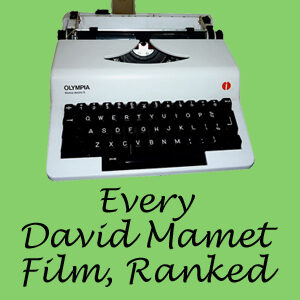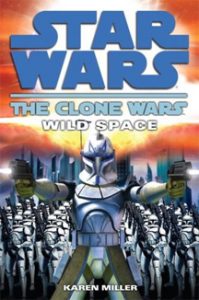Karen Miller’s “The Clone Wars: Wild Space” (2008) isn’t the first “trek through the jungle” novel, as it follows the likes of “Splinter of the Mind’s Eye,” “Heir to the Empire” and “Shatterpoint.” But it’s certainly the most vicious, as Obi-Wan Kenobi and Bail Organa get brutalized to within an inch of their lives on the Sith planet Zigoola. I remembered this aspect of the novel most starkly from my first read – and it’s the reason I dreaded revisiting it. However, it takes up a smaller percentage of the book than I thought; the duo doesn’t crash land on Zigoola until page 236 of this 342-pager.
This part of the book is still a tough read. But before Obi-Wan gets psychologically tortured by a Sith Holocron for 100 pages – with a thirsty, hungry, injured and exhausted Bail repeatedly doing his best to pull him back from the brink – “Wild Space” has a lot to offer. Miller is the most deliberate “Star Wars” writer out there, but that comes with a positive aspect: We get to know what drives Obi-Wan, and more importantly, Bail Organa, as this is the only novel where he’s a central character.
Leia’s adoptive father was first mentioned in the 1976 “A New Hope” novelization and comic adaptation (where he was mistakenly dubbed Bail Antilles), he made his first appearance in 1981’s “ANH” radio drama as Prestor Organa, and he was first introduced as Bail Prestor Organa in 1997’s “Paradise Snare.” Even once his full name was finalized, Bail remained on the short list of the most underexplored prominent movers-and-shakers in the “Star Wars” narrative, so this novel is important, as we (and Obi-Wan) see that the brave Bail – like Padme – isn’t a stereotypical politician. While Bail makes several appearances in “The Clone Wars” (and some more in “Rebels,” for those who follow the Disney continuity), “Wild Space” remains the essential novel for getting to know this man.
“Wild Space” is thinly plotted. It’s merely about Bail and Obi-Wan searching for a Sith planet; they find it, then they barely survive. Although Zigoola doesn’t come up again as an important dark-side location (Korriban seems to hold the title as the Sith home base), it does have the most “Get out!” aspect of any dark-side planet, as Obi-Wan is stripped of the light side and bombarded with nightmares, visions and a voice telling him to drop dead. By comparison, Korriban – which is merely vaguely creepy in most portrayals — is a relaxing resort world.
With the way she puts Bail and Obi-Wan through such misery, Miller is arguably one of the most “adult” “Star Wars” novelists, yet many of Obi-Wan’s nightmares involve plots and characters from Jude Watson’s junior-reader “Jedi Apprentice” novels, when Obi-Wan is training under Qui-Gon. Between this and “Matt’s Expanded Universe,” I now intend to read those books someday to enjoy a fuller picture of Obi-Wan’s life.

Miller’s mission is not to expand the plot or even necessarily the characterizations, it’s to expand the mood and tone, and also to delve into the questions of who knows what when. Notably, Bail learns about the existence of the Sith here, and Miller delves into the Jedi Council’s position of not announcing the Sith’s re-emergence to the populace. The book starts even before “Episode II” is over, as Yoda and Mace oversee the loading of Jedi and clone corpses in the wake of the Battle of Geonosis. “The Clone Wars” TV series may have gone on to give us a more kid-friendly portrayal of the war than the 2002-06 “Clone Wars” saga, but Miller is having none of that in this first original novel based on the TV series; this is grim stuff from the get-go.
At first, it seems “Wild Space” can be placed with “The Truce at Bakura” (immediately after “Return of the Jedi”) and Marvel Issue 7 and Marvel U.K.’s “The Day After the Death Star” (immediately after “A New Hope”) as rare stories that happen in the immediate aftermath of a movie. However, it soon jumps ahead to after the Battle of Christophsis (from the “Clone Wars” movie). (In terms of continuity, the bulk of the 2002-06 Clone Wars saga takes place during that short jump in time, since Anakin is a Padawan in most of those stories and he’s a Knight in the 2008-14 “Clone Wars” saga.)
On another continuity point, the sidebars of Anakin and Ahsoka fighting a space battle against Grievous come from the Season 1 episodes “Downfall of a Droid” and “Duel of the Droids.” I get the sense that Miller was asked by her editors to add this B-plot to provide the occasional reprieve from the brutal A-plot. Unfortunately, this quick add-on leads to what feels like a plot hole: Anakin reports to the Council that he has lost Artoo, and he never finds him again in “Wild Space.” Unless a reader makes the connection that Anakin’s plot comes from the TV show (which I would not have, until I read the entry in “The Essential Reader’s Companion”) – and that he’ll eventually find Artoo – it’s shocking that this thread is dropped in the book.
While Miller’s deliberate style and slow pacing can be intimidating, I’d like to point out a detail that illustrates why the EU is superior to the Disney “Star Wars” galaxy: the difference in communications through space. As Obi-Wan and Bail follow their contact’s directions through various hyperspace jumps, they can send communications only when they are in realspace. For example, Bail at one point wants to shoot a message to his wife, Breha, before they make a jump. Season 3 of “Rebels” shows Ezra having a live exchange with Mon Mothma while his ship is traveling through hyperspace! Similar to the Millennium Falcon’s ability to jump to hyperspace through a shield in “Episode VII,” this is a functional rule that makes Disney’s “Star Wars” seem convenient and small. The fact that Bail and Obi-Wan can’t send or receive messages while in hyperspace is a logistical challenge, but it adds crucial verisimilitude that makes the galaxy seem big and foreboding.
“Wild Space” itself is foreboding, but it’s also rewarding if you’re willing to spend intimate time with Bail and Obi-Wan in what has to be the most challenging mission of the former’s life, and arguably the latter’s too. On that note, I appreciate “Wild Space” itself much more now that it’s part of a finite Expanded Universe rather than an infinite one, and I’m actually looking forward to re-reading Miller’s other two books to get deeper insight into Anakin and Ahsoka as well.

